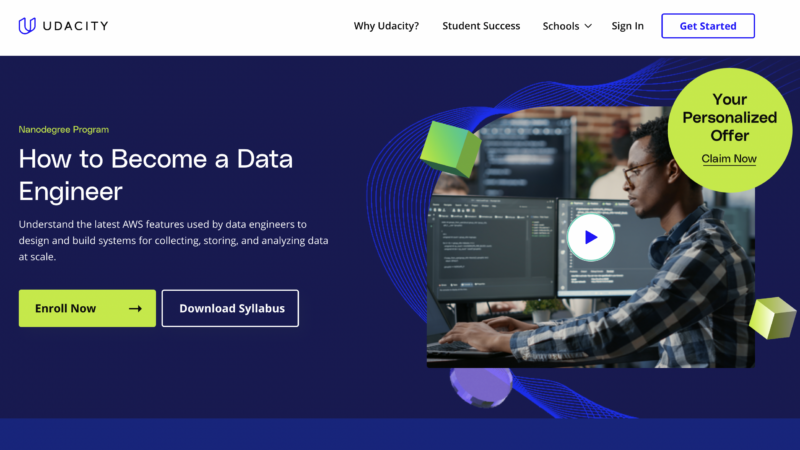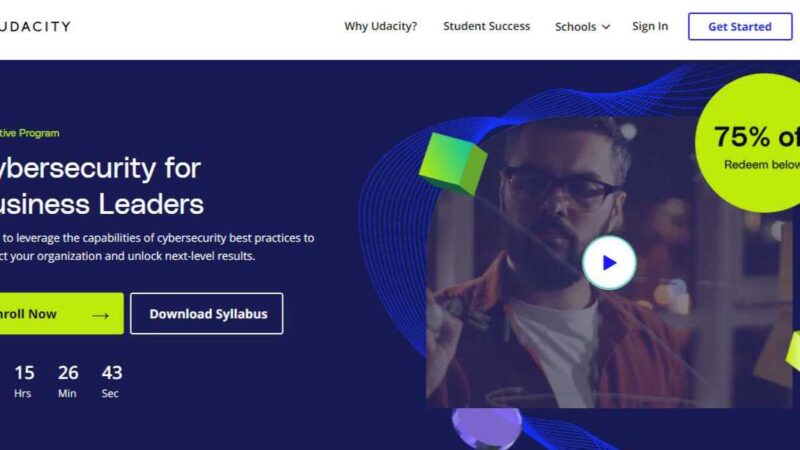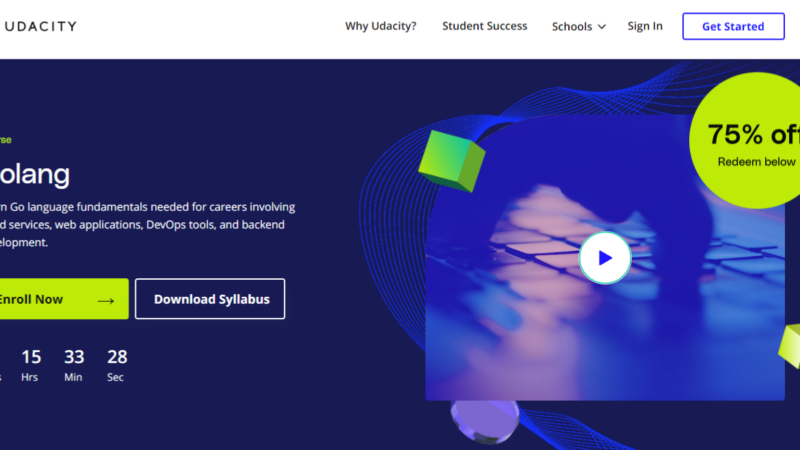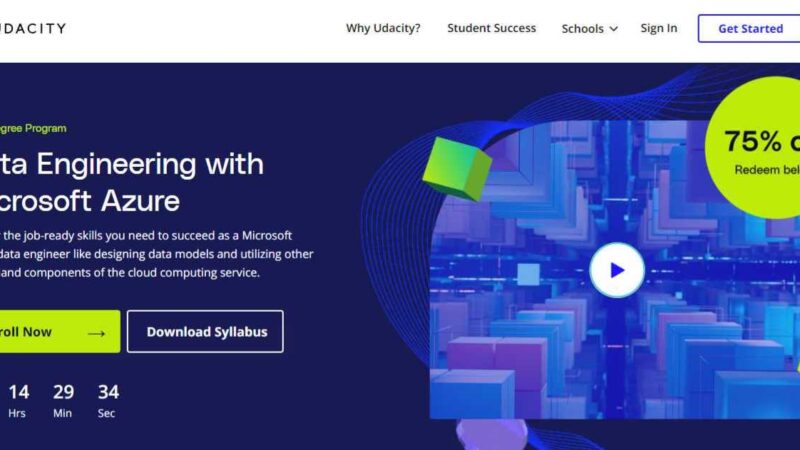Udacity AI Programming with Python Nanodegree Review

Python is a powerful programming language that opens up a world of opportunities. Its heavy use of complex algorithms in sync with carefully constructed networks has the power to bring things to life, evolving the world of AI like we may have only dreamed. AI is said to be a career of the future, increasing in complexity as technology becomes more advanced. As more and more businesses begin to rely on technology to get the job done, knowledgeable individuals with experience in the field are increasingly in high demand. If you’ve thought about working with AI, Python is a language in which you must be proficient. To start working with its structure and see how it fits into the construction of future technologies, you’ll first need to set a strong foundation.
These foundational skills can be learned in many places, one of which is an online academy like Udacity. If you’ve never heard of the academy, we will introduce you to it, followed by an in-depth look at their AI Programming with Python Nanodegree. This course is said to come with the knowledge you need to break into the field, introducing you to Python and its applications in the world of AI. Included in our review is a look at the job market as well, giving you a well-rounded view of what you would be stepping into.
Who is Udacity Again?
It’s surprising if you’ve never heard of the online academy. Since their world wide web introduction back in 2012, they’ve been making powerful splashes and pumping out graduates that have landed jobs with A-list companies. They began as an idea from two Stanford University professors with a vision for bringing education to all. Throughout the years, they’ve teamed up with several industry leaders to offer degree programs and job placement for any and every one with an interest in IT.
What are Nanodegrees?
A nanodegree is said to be anything that takes less than a year to complete. They tend to focus on one specific area of the field, constructing a curriculum based around it. With Udacity, the nanodegree programs not only come with a certification after successful completion but, a whole range of services throughout the duration of the course. These include:
Real Projects
To help you gain some hands-on experience before ever stepping foot into the industry, each course comes with projects that closely mirror real world projects. These get reviewed by experts in the field and include usable feedback to help you improve
Help When you Need It
You’ll have access to a community of learners just like you. Here, you can make connections to make the course run smoother or seek out help if you’re having trouble with the course load. Not only is the community there for you but, you’ll have a mentor at your side if there’s any technical difficulties along the way.
Powerful Career Pointers
Once you’ve completed a course, you’ll have the chance to gain access to the Udacity career database. Here, it is not uncommon to find recruiters that are looking for their next team members. Before that, you’ll have a shot to improve your resume and practice for your first interview with a knowledgeable member of Udacity career services. If that isn’t enough, you’ll also get feedback on your LinkedIn profile and a review of GitHub.
Who are the Instructors?
Another area of the academy that gets a lot of attention is the staff. Courses are led by some impressive instructors that have worked with huge leaders in the industry. For this course, your instructors are:
Ortal Arel
After completing her PhD in Computer Science, Ortal took her knowledge to cryptography as a researcher. Other work she’s dabbled in includes algorithm analysis and digital construction.
Luis Serrano
As a former machine learning engineer with Google, Luis has both industry knowledge and experience. He shares a bit of that in his teachings along with a strong focus on his expertise, mathematics.
Jennifer Staab
Previously staffed at RTI, Jennifer is an expert in statistics and biostatistics. Her PhD in computer science would land her at Florida Polytechnic University where she would become a professor.
Juan Delgado
As a physicist, Juan has worked with astronomy and was even incorporated into part of the team at NASA. His experience includes writing up and working with complex software with the purpose to process large amounts of data.
Grant Sanderson
Grant is a YouTube sensation with a sharp focus on teaching mathematics. He previously worked with Khan, helping the team to develop some contents.
What do I need to Begin?
This a bit beyond an introductory course but, will lead you through from start to finish with most of the concepts introduced. Before beginning, the academy recommends a few things to have both you and your computer up and ready to go. Apart from basic computer skills, for a course of this kind, a background in math like basic algebra is a must. Plus, it is good to have some knowledge with a programing language of some kind. As far as your computer goes, make sure that it is equipped to handle OS X or Windows.
If a few of these prerequisites fall outside of your current skillset, you can find a long list of courses available from the academy. Udacity offers many free courses, especially dealing with foundational knowledge. You can find a full list if you need to brush up on anything here: https://blog.udacity.com/category/free-courses
Course Breakdown
The course is broken down into 5 sections. These are meant to lead you through step by step as you build up the knowledge necessary to complete the course and work on real problems. We will take a look at each section, giving you a bit of insight to what you’ll be learning.
Introduction to Python
Right away, you’ll start gaining the knowledge necessary to construct a strong foundation in the language with an introduction followed by application. At the end of the knowledge you receive during this section of the course, you’ll work with image classifiers to write up a program worthy of identifying the breed of a dog.
Jupyter Notebook and Friends
Here you’ll be cordially introduced to the tools that you’ll be using when working with data. These tools include:
- Anaconda
- Pandas
- NumPy
- Matplotlib
Reintroduction to Linear Algebra
You might recognize many of the words and concepts in this section as you have seen them before. This time however, you’ll see how they are used in complex AI constructions like neural networks.
Brush up on Calculus
Again, you’ve possibly seen a few of these concepts. Here too, you’ll get a glimpse of how these are used during the building of neural networks, actually getting to see how they fit together to make the bigger picture possible.
Neural Networks
This is where you’ll see how it all comes together. A combination of both math and neural network building creates an architecture for data to flow through seamlessly. This is perhaps one of the most important foundational concepts that can take you on to more advanced areas like deep learning. At the end, you’ll build your own image classifier from the ground up using the techniques you learned throughout the course.
How Long will This Course Take?
Every person is different and so too is the pace at which they learn. Thanks to Udacity’s flexible learning, you can take all the time you need. You’ll have the power and freedom to login when you’d like and spend as much time per login as you see fit. But, to get a bit of an idea, Udacity offers an estimate of the total time it will take to complete the course.
Their estimate, if spending only 10 hours per week, is three months. That’s right, only three months to complete the course at only 10 hours a week. While this may leave you totally laxed, you might want to reconsider your stance. This is because the time it will take you has an affect on the price, one that you’ll want to pay attention to.
What’s the Cost?
If you’re thinking of enrolling soon, you’re in luck. That’s because for a limited time, the academy is offering a free month to all learners. This free month comes no matter which option you choose to pay, of which you have two.
Pay as you go
This is calculated by monthly access. Every month that you have access comes with a price tag of $359, which could possibly add up if you’re taking things too slowly. Still, you’ll get a shot at your first month free and can pay for your access after that.
Bundle it up
To promote a more scheduled approach for both you and the academy, you can go with Udacity’s estimation and pay up front. This way comes with a discounted monthly cost, where the total is $206 per month. Add in that extra month and you have four whole months to complete the course.
What have Learners Said?
It’s always a good idea to look to those who have taken the course for some insight. Overall, the course seems to have a good rating, scoring a 4.6 out of 5 stars. Here is what learners has to say along with the rating they gave.
“I like this course because it gives knowledge both on basics of Python and on basics of machine learning. Some exersizes were challenging, so I needed more time to complete them. Study materials are informative and well structured. I also like the supportive services Udacity provides, like personal mentor, students forum, planner, study challenge #30DaysOfUdacity.” (5-Star)
“Summary: Good content, but expect to do this completely by yourself. Most mentors don’t even reply to your messages. For 300$ I suggest you simply study Pytorch tutorials for beginners and watch 3Brown1Blue’s AI videos. The course jumps from explaining AI and implementing it in basic but interesting ways to using purely Pytorch and using pre-trained networks…” (2-Star)
A Look at the Job Market
It is rumored that this field is still in its very early stages. It is thought that this field will become more useful and more powerful as technology advances. These advancements go hand in hand, allowing those with programming and architectural knowledge to construct reusable code to power devices of the future. According to an in-depth analysis of the field by Gartner, there was a 270% increase from the years dating back from 2019. The largest jump was in the last year, where the total leapt up 37% from its already high point.
PayScale reports the average entry level salary for those that have Python programming knowledge powerful enough to break into the world of AI to be upwards of $73,500 annually. Even just holding the skills of Python, as a developer, the average salary is more than $77,000 according to DevSkiller.com. Of course, like many other skillset jobs of this kind, the more expertise you gain, the more in demand you will be and the higher you will be paid.
The Take Away
A career as an AI Programmer is, at the very least, interesting. You’ll be a part of a revolution in software helping to build complex systems that make their function possible. As more companies make their way into the digital world, they need knowledgeable individuals with both skills and out of the box thinking to make their visions a success. Just like with many other jobs of this sort, some type of knowledge is necessary, which you can get from an academy like Udacity.
While the decision is ultimately yours, we are quite fond of the academy and love the partnerships they’ve made and those that are in the works. While the cost is sometimes unfavored by learners, the free month offer puts that concern to rest, leaving only the curriculum and staff to ponder. If you’re thinking about a career that requires Python, this could be a great starting point for you and your future career.




